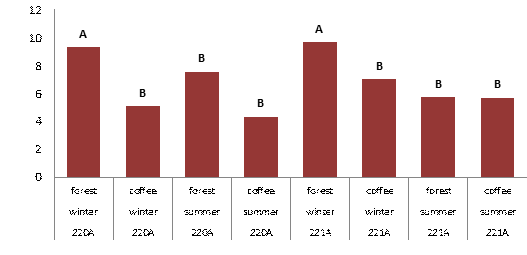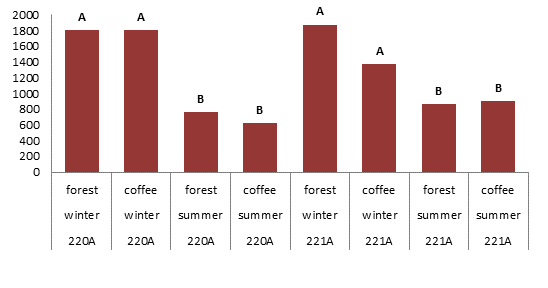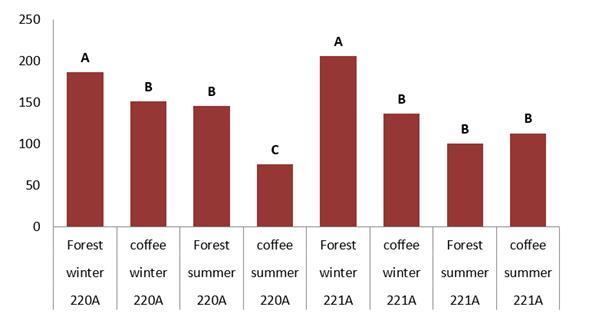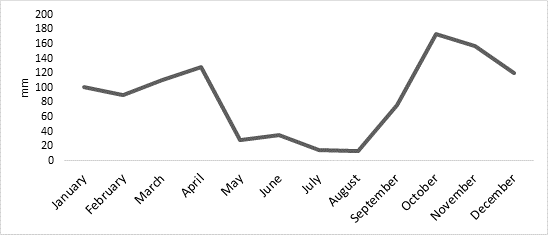INTRODUCTION
In nature, the soil is the place where the highest concentration of species is found, considered to be one of the places with the highest specific richness on Earth (Barthlott et al., 2007). These ecosystems have been threatened by changes in the type of coverage and land use, exacerbating many processes of soil degradation, generating changes in the distribution of water, and promoting extreme climatic events (Parry et al., 2007). Besides, agricultural systems have great influence on organisms in the soil, including their activities and biodiversity (FAO, 2015). In addition, the clearing of forest lands or pastures for cultivation affects the soil environment and drastically reduces the quantity and number of species of soil organisms, due to anthropic activities (Fortanelli and Servín, 2002).
The identification of biological traits as indicators of soil quality is of great importance for making decisions that promote its conservation and rational use for agricultural production.
In addition, this information is relevant as it allows us the understanding of the role that these organisms play in the soil to generate its sustainability and quality (Navia, 2007).
The macrofauna plays a fundamental role between the soil and its renewal rate (Marinari et al., 2006). Due to its high variability over time, sensitivity, and ability to reflect the effects of soil management in the short term (Cluzeau et al., 2012; Paolini, 2017; Muñoz-Rojas, 2018), it is important to implement strategies that promote long-term soil sustainability (Muscolo et al., 2015). These organisms give the soil characteristics of a living system that must undergo an assessment of the state of the macrofauna in the productive systems, generating indicators that determine biodiversity, which ultimately allows the prediction of future environmental impact (Jiménez y Thomas, 2003;Huerta et al., 2008).
Organisms in the soil perform essential functions, especially in the transformation of organic matter through disintegration processes (Muscolo et al., 2015). Additionally, their role is observed in the predation of microbes, the modification of the structure of the soil, and the decomposition of organic matter. Crushing the plant and animal remains that fall to the ground and reducing their size and volume allows for a cycle of assimilation and distribution of organic matter. It begins from the function of the macrofauna to the different actions of microorganisms through various soil horizons, constituting a contribution of nutrients to the plants, which in turn contribute to said cycle (Coyne, 2000).
They are multifunctional within their ecosystems and have an effect that goes beyond mediating physical, chemical, and biological processes in the soil. Since their actions extend throughout the soil profile, their influence impacts fauna, flora, man, water and air quality, soil sustainability over time, and social well-being (Paolini, 2017).
On the contrary, in systems with agroecological management such as agroforestry systems or forests, greater efficiency of organisms has been observed in the use of energy and nutrients for their maintenance and growth (Paolini, 2017). Similar observations are made in the carbon transformation processes including mineralization, immobilization, and the formation of humic substances (Braga and Gonçalves, 2016), allowing a greater balance between the entry and exit of carbon from the system, in such a way that greater carbon sequestration in the soil can be induced (Altieri and Nicholls, 2013).
Terrestrial invertebrates are distributed depending on factors such as rainfall or the climatic factors that define soil temperature and humidity, which are the edaphoclimatic variables that most affect the biota of the tropical soil. In the rainy season, the greatest diversity and abundance of edaphic fauna is shown since water contributes to vital processes of these organisms such as respiration, reproduction and feeding (Souza et al., 2016). However, studies indicate that the quantity of organisms is determined by environmental conditions- mainly temperature and humidity- which favor the presence of trees in the silvopastoral arrangements, the amount of rotting organic material accumulated in the soil, and the nutritional status of plants of the arboreal stratum (Sánchez et al., 2011).
In addition, the activity of organisms can be analyzed as microbial biomass, which refers to the size of the community present in the soil (Paolini, 2017; Chavarria et al., 2018), or the living fraction of organic matter (Cluzeau et al., 2012; Braga and Gonçalves, 2016).
The present work, therefore, aims to evaluate the response of the macrofauna present in the soil in different environmental systems during two seasons of rainfall in different environments (ecotope) in the department of Nariño.
MATERIALS AND METHODS
Localization. This work was carried out using two coffee ecotopes in southern Colombia. Ecotope 220A- coordinates ranging from 1°21' to 1°42'LN, with altitudes of 1300 to 1800 meters above sea level and an annual rainfall of 1700 to 1900mm- and Ecotope 221A, located between 1°05' and 1°36'LN, between 1400 and 2100 meters above sea level with an annual rainfall of 1400 to 1700mm (FNC, 1991).
Treatments. Sampling was carried out in two coffee ecotopes of Nariño’s department that correspond to ecotopes 220A and 221A. Samples were taken at two times of the year: winter (March and April) and summer (July and August), as seen in Figure 1 and Figure 2, as well as from two different soil sources: a two-year established coffee plantation and a nearby natural forest.
Field evaluation. Sampling was carried out at three different altitudes (repetitions): 1) lots located below 1600 m a.s.l.; 2) lots located between 1600 m a.s.l and 2000 m a.s.l.; and 3) lots located above 2000 m a.s.l. The sampling sites were identified, and monoliths measuring 0.25 x 0.25 x 0.20 including the mulch layer were obtained. Previously labeled plastic bags were placed and stored using the TSBF (Tropical Soil Biology and Fertility) methodology described by Anderson and Ingram (1994).
Organisms’ selection. The macrofauna from the soil was collected manually. Subsequently, the samples were left in Berlese funnels for a period of 96 hours. The individuals collected (both in the manual review and in the sample processed by Berlese) were stored in labeled jars; arthropods were stored in 70% alcohol and annelids in 5% formaldehyde.
Variables Evaluated
Order density. With the help of a stereoscope, the organisms found were identified, counted, and classified according to order level; then the information was systematized.
Individuals’ density. Once the organisms had been identified, the number of individuals present in one square meter of each system was counted.
Biomass. In each sampling, the biomass was established, and the grams of fresh weight of the individuals per m2 in each of the treatments was calculated using a precision balance.
Statistical processing. The non-parametric statistics Kruskal-Wall test was used to determine statistical differences in the variation of order density/ m2, individual density/m2, and biomass/m2 by ecotopes, times, and systems.
RESULTS AND DISCUSSION
The average values for the variables order density/m2 (DO), density of individuals/m2 (DI), and biomass/m2 (B) are shown in Table 1, presenting highly significant statistical differences (P. Value 0.05%) for order density/m2, density of individuals/m2, and biomass/m2.
Table 1. Kruskal-Wallis test for variables order density/m2, density of individuals/m2 and biomass/m2.
| Means | |||||
|---|---|---|---|---|---|
| Ecotope | Season | Use | DO | DI | B |
| 220ª | Winter | forest | 9.33 | 1802.67 | 186.5 |
| 220ª | Winter | coffee | 5.11 | 1808.22 | 151.61 |
| 220ª | Summer | forest | 7.56 | 759.11 | 146.12 |
| 220ª | Summer | coffee | 4.33 | 624 | 75.55 |
| 221ª | Winter | forest | 9.67 | 1876.26 | 205.74 |
| 221ª | Winter | coffee | 7 | 1368.56 | 136.27 |
| 221ª | Summer | forest | 5.74 | 862.44 | 100.44 |
| 221ª | Summer | Coffee | 5.7 | 902 | 113 |
| P- valor | <0.0001 | 0.014 | 0.0004 | ||
Order density. The highest order density was evident in the winter season forest system in ecotopes 220A and 221A, presenting averages of 9.33 orders/m2 and 9.67 orders/m2 respectively. These values statistically exceed the number of orders that the forest presented in the summer season in the two ecotopes and coffee system in the rainy season, and in the summer season in the 220A and 221A ecotopes, with averages ranging from 7.56 orders/m2 to 5.11 orders/m2 (Figure 3).

Means with a common letter are not statistically different (p > 0.05)
Figure 3. Means for the variable density of orders/m2 in two ecotopes, two epochs and two systems.
This is probably a result of the high humidity rates presented in the forest due to greater vegetation and rainfall, in turn creating a better relationship between the system and the microorganisms. On the other hand, Masters (2008) argues that the changes in the minimum humidity conditions of the soil bring, as consequence, lower availability of residues, affecting some taxa that normally require permanent moisture, as is the case with Oligochaeta or earthworm.
Cabrera et al. (2019) found similar results when evaluating biodiversity in two rainfall regimes in southern Mexico, identifying 16 taxa that corresponded to arthropod fauna. Likewise, the abundance of most of the groups corresponded to soil with native vegetation. Using a non-parametric test, the differences in the composition of the edaphic fauna between the land uses were confirmed, showing a significant effect at the time of year.
In a study of the soil macrofauna of a Zea maiz crop during the postharvest phase in winter, Villalobos et al. (2000) reported 46 morphospecies. Similar results were obtained by Amazonas et al. (2017) who found 15 taxonomic groups evaluated in a forest restoration system (in both summer and winter), discovering great variation in density in the taxonomic groups.
Density of individuals. the highest number of individuals/m2 was observed in the winter season in the forest and coffee systems in both ecotopes 220A and 221A, with averages ranging from 1808 individuals/m2 to 1368 individuals/ m2, statistically exceeding the number of individuals/m2 that occurred in the summer season in both coffee and forest in the two ecotopes. Their averages vary from 902 individuals/m2 to 624 individuals/m2 (Figure 4), with the most dominant taxa being Hymenoptera, Acari, Coleoptera, Isopoda, and Polydesmida.

Means with a common letter are not statistically different (p > 0.05)
Figure 4. Means for the variable density of individuals/m2 in two ecotopes, two seasons, and two systems.
Cabrera (2012) argues that probably, the lack of food for soil organisms generates an imbalance in the system. In the same way, individuals can be affected by factors such as climate, humidity, texture, and properties. Soil chemicals- in particular, those who feed on rotting material- are very sensitive to sudden changes in humidity and temperature because they live on the soil surface and under conditions of water stress and high temperatures, so due to the lack of plant cover, they tend to disappear. Gálvez et al. (2016) showed similar results to those obtained in an investigation carried out in two systems: silvopastoral and conventional. They found that the abundance of macrofauna was higher in the silvopastoral system, with 4668 individuals per square meter, of which 4016 individuals were presented in the rainy season and 652 individuals per square meter in summer. With the conventional system, on the other hand, they obtained 1968 individuals per square meter; a greater abundance was seen in the rainy season (1392) than in the summer (576).
Suárez et al. (2015) carried out studies on the composition of the edaphic macrofauna associated with the agroforestry arrangements and two seasons (maximum and minimum precipitation), finding results in accordance with those reported. The number of individuals collected was higher in the season of maximum precipitation (1129 individuals) compared to those collected in the season of minimum rainfall (598 individuals). Among the agroforestry arrangements that presented higher densities in certain taxonomic groups, they found Oligochaeta Diplópodo, Isoptera Araneae, and Coleoptera.
In a study carried out in Cuba that examined two systems, they found that in summer, among the study sites, there was a great predominance of insects and a density of the total macrofauna of 1298 ind.m-2. This supported the theory that during this season, there is a greater number of individuals as runoff is not generated as it is in the rainy season (Cabrera et al., 2017).
Biomass. The highest contribution of biomass was presented during the winter season in the forest system in the two ecotopes with averages of 186.5 grams/m2 in ecotope 220A and 205.74 grams/m2 for ecotope 221A. This value exceeded the biomass that was found in coffee in the rainy period, both in ecotope 220A, with an average of 151.61 grams/m2 and ecotope 221A, with an average of 136.27 grams/m2, as well as the biomass that occurred in summer, both in forest and in coffee, in the two ecotopes with averages of 146.12 grams/m2 and 100.44 grams/ m2. An exception was seen for ecotope 220A in drought in the coffee system, with an average of 75.55grams/m2 with a differential behavior (Figure 5).

Means with a common letter are not statistically different (p > 0.05)
Figure 5. Means for the variable biomass in two ecotopes, two seasons, and two systems.
Haplotaxida was the group that presented the highest biomass contributions in all systems, which can be an indicator in situations such as contamination by pesticides and heavy metals, compaction, organic matter content, and water conditions in the edaphic environment (Cabrera et al., 2019), followed by the order Coleoptera and Hymenoptera.
Pardo (2006) reported similar results in an evaluation carried out in a different pasture, coffee plantation, and secondary forests, where the biomass totaled 1194.006g, equivalent to 99.50 g m-2. The most important groups present were Myriapods (59%), earthworms (8%), chisas (3%) ants (2%), and spiders (1%).
CONCLUSIONS
The order density is affected by the rainfall of the season, presenting a lower density in summer.
The highest number of individuals was observed in the rainy season, both in the coffee and in the forest system, in ecotopes 220A and 221A, which indicates that the two systems can host great diversity. On the contrary, the limitation of humidity in the soil brought with it a reduction in the number of species present.
Due to the fact that optimal feeding conditions are present for all soil hosts, the greatest contribution of biomass was presented in the winter season, being the Taxon Haplotaxida of great importance for biomass contribution.
















